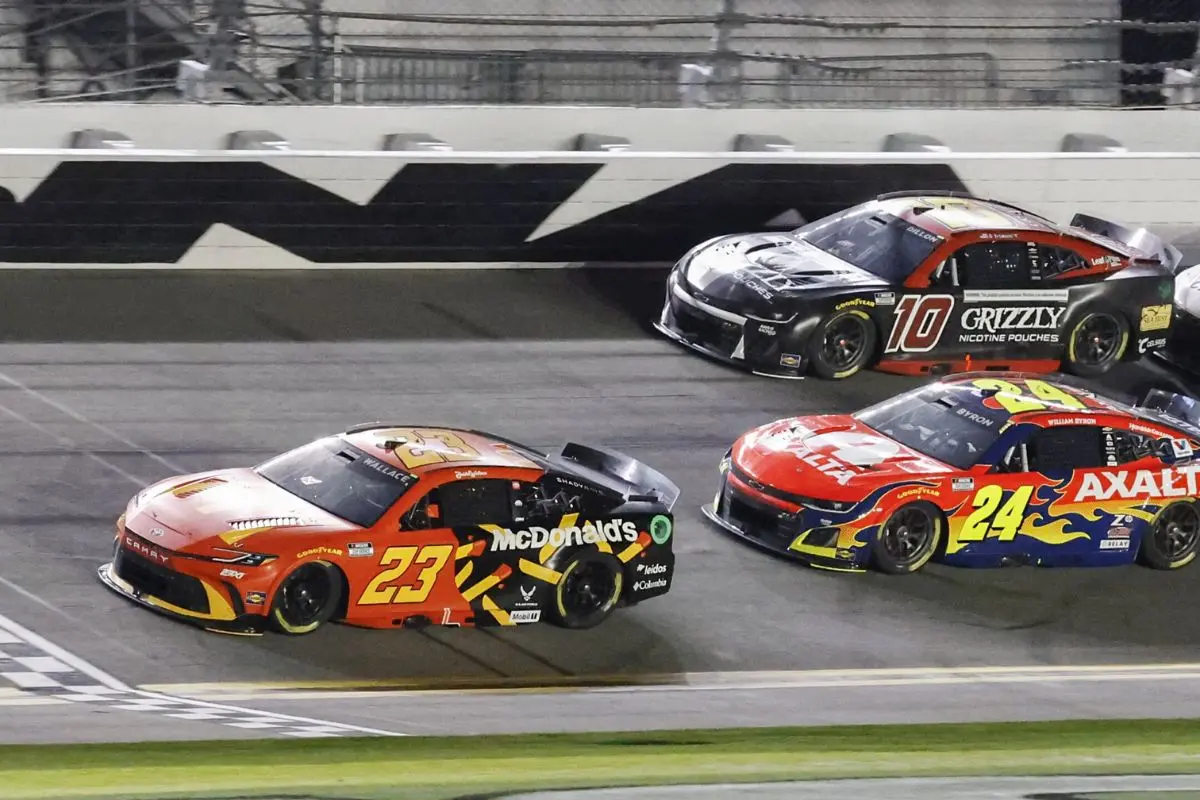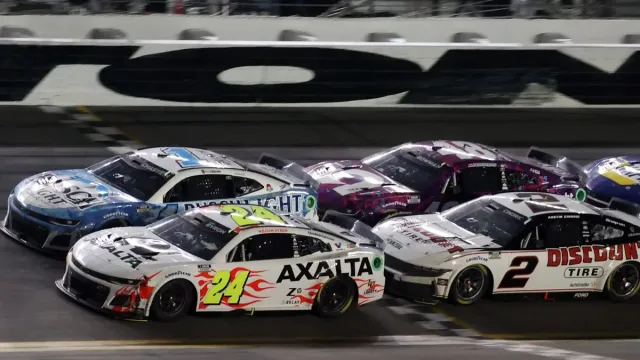Key Highlights
- NASCAR acknowledged fan outrage over caution calls during the Daytona 500, emphasizing the need for improved race management.
- Officials expressed regret over the impact of caution flags on the race’s outcome and competition integrity.
- The late-race caution involving Denny Hamlin was particularly controversial and led to William Byron’s unexpected victory.
- NASCAR is committed to refining emergency response timing to minimize race flow disruptions and ensure fair finishes.
- There are plans to adjust caution flag deployment procedures to balance safety and race excitement.
Daytona 500 Wreck-Fest and Rising Concerns
The Daytona 500, traditionally a grand spectacle of speed and strategy, devolved into what many are now calling a “wreck-fest,” raising considerable concerns about the current state of NASCAR’s officiating and safety protocols.
The 2025 season opener saw an unprecedented number of crashes, with 35 cars involved, marking the highest since 2019. Team Penske’s dominance across 125 of the 201 laps was abruptly halted when reigning Cup Series champion Joey Logano, alongside his teammates, encountered misfortune, exiting the race during a turbulent lap 186 collision.
The frequency of collisions highlights the escalating intensity on the track, prompting examination over NASCAR’s executive decisions, particularly concerning late-race caution flags.
Such calls, pivotal in race outcomes, are increasingly viewed as contentious, with the potential to compromise competition integrity and driver safety. This development accentuates the pressing need for NASCAR to reevaluate its strategies to improve safety without diminishing the sport’s exhilarating nature.

Controversy Surrounding William Byron’s Win and NASCAR’s Decisions
Controversy remained over the 2025 Daytona 500 as William Byron’s unexpected victory sparked widespread debate about NASCAR’s pivotal decisions regarding caution calls. Fans questioned the legitimacy of Byron’s win, as a late-race incident involving Denny Hamlin dramatically altered the outcome.
Byron, initially in seventh place, surged to the front when Hamlin’s crash triggered a chain reaction. Furthermore, criticism was directed towards the caution flag preceding the finish of the subsequent Duel race, fueling discontent among enthusiasts.
ABSOLUTE INSANITY 🤯
Hamlin and most of the leaders crash, but @WilliamByron sneaks through the carnage to go back-to-back in the #Daytona500 😧
🎥 @NASCAR pic.twitter.com/dzwAo2Gw09
— Motorsport.com (@Motorsport) February 17, 2025
The data reflects the contentious nature of the race:
| Incident | Impact | Resulting Position Change |
|---|---|---|
| Hamlin’s Crash | Triggered massive wreck | Byron advanced to 1st |
| Qualifying Crashes | 13 cars involved | 48 wrecked cars total |
| Duel Race Caution | Premature flagging | Debate over race outcome |
Jusan Hamilton, NASCAR’s race director, expressed regret over these decisions, acknowledging the challenges of real-time judgment compared to post-race analysis.
“So hindsight is always 20/20, and that’s one when you look back, I would say we could do it differently.” – (Hamilton)
“I would say that we could let them get to the start/finish line, but that’s looking back now on a Tuesday, going through all of our reviews and having the luxury of time to review the full situation.” – (Hamilton)
NASCAR’s Response and Future Approach to Caution Calls
In response to the controversy surrounding caution calls at the Daytona 500, NASCAR officials, led by race director Jusan Hamilton, have articulated a commitment to refining their approach to race management, particularly in relation to how caution flags are deployed.
Hamilton clarified that the timing of emergency responses, such as deploying fire trucks and ambulances through tactical cutouts in Turns 1 and 2, is calibrated to coincide seamlessly with green-flag conditions. This tactic guarantees that incidents are addressed promptly without unnecessary interruptions to the race flow.
“As soon as the wreck happens, because all vehicles have passed by that Turn 2 cutout, we’re able to respond, sending the fire trucks, the ambulances, the AMR chase vehicles to respond to that incident before the leaders even made it to the checkered, even though there’s no caution.” – (Hamilton)
He emphasized that NASCAR’s overarching objective is to achieve green-flag finishes, minimizing the influence of race control on the outcome. By refraining from hastily deploying caution flags, NASCAR aims to allow competitors to determine the race’s resolution.
“Moving forward and always, our goal is to get to a green-flag finish. We do not want to be the ones determining the race by how fast we push the caution button or the decisions that we make in race control in general. We want that to be decided by the competitors on the ground. So any opportunity that we have to do that, we’re going to take advantage.” – (Hamilton)
Despite these assurances, the organization faces dissatisfaction from drivers, who express concerns over the chaotic nature of the race, underscoring a delicate balance that NASCAR must navigate going forward.

Driver Safety Concerns and Future of Superspeedway Racing
As NASCAR grapples with refining its race management strategies to guarantee fair competition, the focus shifts towards an even more pressing issue—driver safety concerns in superspeedway racing.
The tragic demise of Dale Earnhardt Sr. in 2001 served as a pivotal moment for NASCAR, leading to improved safety protocols. However, incidents like Ryan Preece‘s alarming crashes in 2023 and 2025 have reignited concerns.
“I think we know there’s a problem at superspeedways. I don’t want to be the example of when it finally gets somebody. I don’t want it to be me. I’ve got a 2-year-old daughter.” – (Preece)
Preece, voicing the fears of many drivers, highlighted the uncertainty looming over superspeedways with, “I don’t want to be the example of when it ultimately gets somebody.” Restrictor-plate racing, while preventing excessive speed, has its drawbacks:
- Increased pack racing.
- Higher frequency of wrecks.
- Greater reliance on luck over skill.
- Potentially compromised driver safety.
Denny Hamlin’s critique of the Daytona 500’s randomness emphasizes the pressing need for NASCAR to strike a balance between excitement and safety.
“It’s such a f—— crapshoot now…I hate that what is supposed to be our most prestigious race, a showcase of heroes, is luck. It is luck. I don’t care how else you want to say it.” – (hamlin)

News in Brief: NASCAR Admits Regret Over Daytona 500
In view of the Daytona 500’s controversial incidents, NASCAR acknowledges the need to reassess its caution call protocols to guarantee fairness and safety. The backlash following William Byron’s contentious victory highlights the necessity for clearer decision-making processes in races.
As NASCAR reflects on these events, it remains committed to enhancing driver safety and refining the dynamics of superspeedway racing, aiming to restore trust among fans and stakeholders while maintaining the sport’s competitive integrity.
ALSO READ: Daytona 500 Draws Massive Audience in 2025 as NASCAR Sees a Stunning Viewership Increase
